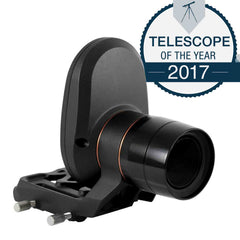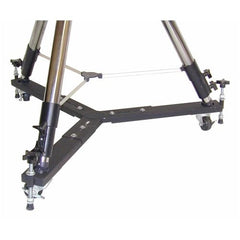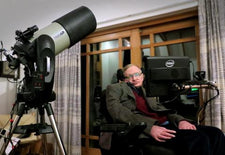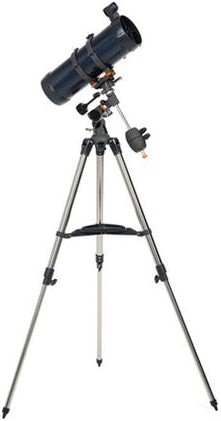Wheelchair Astronomy: The Best Telescopes for Wheelchair Users
September 23, 2015
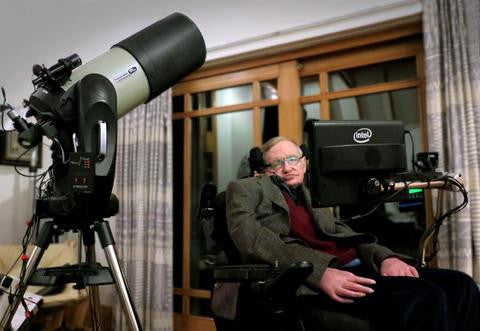
Earlier this year, physicist Stephen Hawking shared his latest hobby with millions of social media followers: amateur astronomy and astrophotography. Using a specialized telescope system from Celestron, Hawking captured striking images of the Orion Nebula, craters on the Moon, and galaxies millions of light years away.
Although he’s lived with the neuron disease ALS for more than 50 years and has spent much of that time in a wheelchair, Hawking’s limited mobility does not preclude a rich and rewarding experience under the stars. After his first night with the telescope, Hawking commented, “[It] opened up the Universe to me.”

With more than 3 million wheelchair users in the United States alone and tens of millions worldwide, there’s now more demand than ever for wheelchair-accessible telescopes. Thanks to recent advancements in technology, it’s become easier and more affordable for wheelchair users to enjoy observing and capturing their own images of the Moon, planets, and beyond. Here, we’ve rounded up several options at varying levels of mobility and price points.
Getting Started with Astronomy Binoculars
Before the advent of computerized telescopes, most amateur astronomers got started in the hobby not with a telescope, but with a pair of binoculars. Although they’re compact and simple to use, binoculars are still the absolute best tool for learning to navigate the night sky. What’s more, they’re ideal for wheelchair users.
While you may be tempted to invest in a huge binocular, you might be surprised to find that the views with a standard 50mm model can still be quite good—without the hassle of a tripod. Choose a pair you can comfortably handhold. We love the Celestron Cometron line of binoculars. At less than $35, the Cometron 7x50 is just about as affordable as they come. Its low 7x magnification makes this binocular ideal for scanning the sky. For a slightly beefier option that can still be handheld, try the Celestron SkyMaster DX 8x56 or the Cometron 12x70.
Pair your astronomy binoculars with any of the free stargazing smartphone apps and you’ll be identifying constellations and viewing Messier objects in no time!
Tabletop Telescopes for Wheelchair Users
A compact tabletop telescope on a Dobsonian-style mount is another excellent option for wheelchair users. Either placed on a separate table or on a wheelchair tray, this scope is easy to point at celestial objects. The special-edition Cosmos FirstScope by Celestron includes a red dot finderscope to easily locate objects in the sky. And with 76mm of aperture, this small-but-mighty telescope renders objects like the rings of Saturn and the Orion Nebula in crisp detail.
If you want to add automatic tracking to your setup, consider the handy Virtuoso mount by Sky-Watcher. A 90mm Maksutov-Cassegrain optical tube sits on a motorized altazimuth mount. Keep in mind that the Virtuoso tracks celestial objects as they move across the sky, but does not locate them for you automatically. You’ll still need to point the telescope at your target.
We especially love the Virtuoso because of its unique bonus features: this mount can also be used for photography! Attach your DSLR camera, camcorder, or even a smartphone with the included adapters and snap perfectly aligned panoramic landscapes or smooth panning video. With all this functionality, this versatile little mount comes in at just $250.
Build Your Own Stephen Hawking Inspired Astrophotography Setup
As we mentioned earlier, the telescope Stephen Hawking uses to image the Universe was specially assembled to work with his Intel-based PC and cheek-controlled switch. The entire rig cost just about $10,000, but you can achieve a similar setup at a fraction of the cost. To put together your own wheelchair-friendly planetary imaging telescope, you’ll need the following equipment, most available on TelescopesPlus.com:
- NexStar Evolution telescope – Celestron’s newest computerized telescope offers the excellent tracking accuracy you’ll need for imaging at an affordable price. Evolution also features built-in WiFi so you can control the telescope via smartphone or tablet from up to 30 feet away. It’s available in 6”, 8”, or 9.25” apertures.
- Celestron StarSense AutoAlign automatic alignment accessory – Just install the camera attachment in place of your telescope’s finderscope and switch it on. In less than 3 minutes, your telescope can align itself to the night sky with no user input needed.
- A dedicated planetary imaging camera and laptop – An inexpensive camera like the Skyris 132 or NexImage Burst replaces your telescope’s eyepiece. Use a USB 2.0 or 3.0 connection to attach the camera to your laptop to view a live stream of images and record video. We also recommend you install The Sky X Pro by Software Bisque to control your telescope.
- JMI’s Universal Wheely Bars – Set up your telescope once and for all! Have someone help you assemble the telescope on this wheeled tripod stand. Whenever conditions look good for a night of photography, have a spouse, friend, or assistant wheel the telescope outside and you’re ready to go.
- A focus motor (optional) – If reaching the telescope’s focuser is difficult, adding a focus motor is an easy fix.
With a telescope kit like this, you’ll capture impressive images of Saturn and its rings, Jupiter and its moons, Mars, Venus, and craters on the Moon.

Sharing Astronomy with Others
No matter which option you choose, one of the best parts of amateur astronomy is sharing the hobby with others. Invite friends or family to join you for a night of stargazing or to view special celestial events like a meteor shower or lunar eclipse.
We’d love to hear your ideas and tips for wheelchair astronomy. Send stories and photos of your equipment to us at info@telescopesplus.com. Clear skies!

